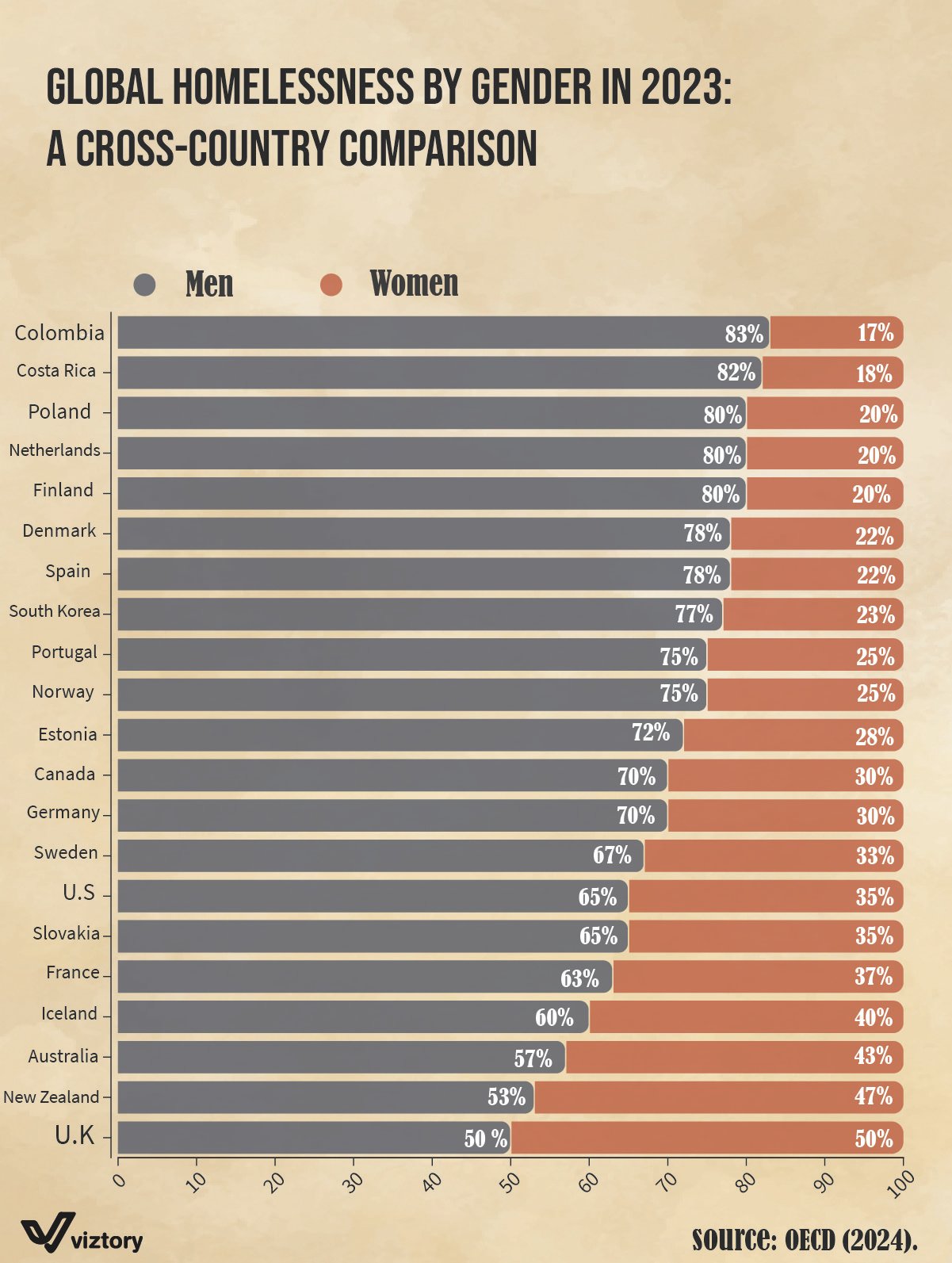Global Homelessness by Gender in 2023: A Cross-Country Economic Perspective
-
Sep, Thu, 2024
Global Homelessness by Gender in 2023: A Cross-Country Economic Perspective
The image titled “Global Homelessness by Gender in 2023: A Cross-Country Comparison” highlights an alarming and often overlooked global issue — homelessness — and presents a striking gender disparity in homeless populations across various countries. Understanding the economic factors underlying this data provides deeper insight into both the causes and the potential solutions to global homelessness.
Gender Disparity in Homelessness
From the image, it is evident that homelessness predominantly affects men in many countries. In nations like Colombia (83% male homelessness) and Costa Rica (82%), the gap between male and female homelessness is significant. However, in more developed economies like the United Kingdom (50% male, 50% female), there is an equal representation of homelessness among both genders.
This gender gap is not uniform across all nations, and various economic, cultural, and social factors contribute to these differences.
Economic Drivers of Homelessness
-
Economic Inequality: Nations with stark income inequality often show higher rates of homelessness. In regions like Latin America, where economic instability is prominent, such as in Colombia and Costa Rica, the rates of male homelessness skyrocket. The lack of access to stable employment, social services, and affordable housing drives people, especially men who are more likely to be employed in informal sectors, into homelessness when economic conditions falter.
-
Social Safety Nets and Welfare: Countries like the U.K., New Zealand, and Australia show lower percentages of male homelessness and a more balanced gender representation, thanks to their robust social safety nets. These countries have comprehensive welfare systems that provide housing support, unemployment benefits, and health services. Economic policies that prioritize public spending on housing and social services contribute to reducing homelessness.
For example, the U.K., with a 50%-50% split between men and women, has some of the most advanced social housing policies in the world. Despite recent budget cuts, government intervention in housing and homelessness prevention programs keeps the rates more balanced. However, the equal gender split could also suggest women are increasingly vulnerable due to specific social pressures, such as domestic violence or inadequate employment opportunities, despite economic support systems.
-
Housing Markets and Affordability: The cost of housing is one of the most critical factors influencing homelessness. In countries where housing markets are unaffordable for large sections of the population, like in the U.S. and Canada (both showing around 65-70% male homelessness), the risks of falling into homelessness increase dramatically. Economic policies that prioritize deregulated housing markets without ensuring affordable housing stock push lower-income individuals, often men, out of stable housing.
-
Gendered Economic Roles: The significant gender gap seen in many countries, especially in Eastern European and Scandinavian countries like Poland (80% men) and Norway (75% men), may also be attributed to the traditional gender roles that see men as primary breadwinners. When economies face downturns, men employed in industries vulnerable to economic shocks, such as manufacturing and construction, are more likely to lose jobs, contributing to higher rates of male homelessness. Women, on the other hand, often receive greater support through family structures or are more likely to be employed in service industries, which are less volatile.
Policy Implications
Economic policies targeting homelessness must consider these gender disparities. Countries with a high male homelessness rate could focus on creating jobs in sectors where men are disproportionately affected, while also offering comprehensive mental health and addiction support services. In contrast, in countries where homelessness is more balanced between genders, such as the U.K. and Australia, economic policies should address the underlying issues that affect women, such as domestic violence and employment discrimination, while maintaining strong housing affordability programs.
Conclusion
Homelessness is not just a social issue but an economic one, deeply connected to the policies, economic health, and welfare systems of each country. Addressing homelessness requires comprehensive economic strategies that balance housing affordability, welfare, and employment opportunities, all while considering the gendered dimensions of homelessness. The stark disparities presented in the image underscore the need for targeted, economically-informed interventions to mitigate homelessness on a global scale.

